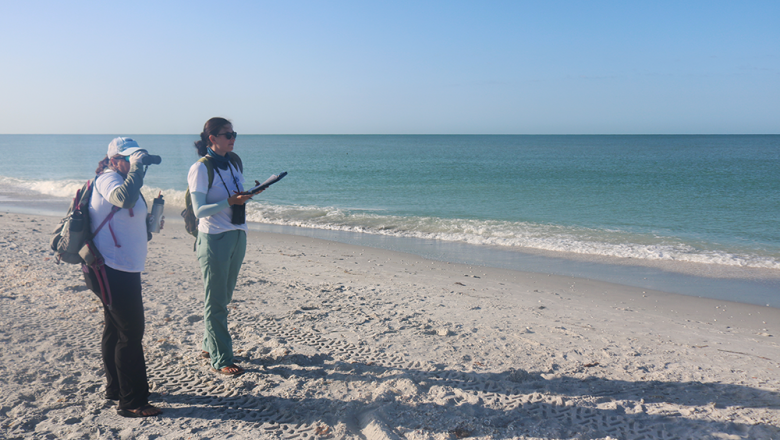
SCCF shorebird biologist Audrey Albrecht (left) and shorebird intern Elsa Wilson (right) survey shorebirds near Bowman’s Beach. (Sarah Anderson/MEDILL)

SCCF shorebird biologist Audrey Albrecht (left) and shorebird intern Elsa Wilson (right) survey shorebirds near Bowman’s Beach. (Sarah Anderson/MEDILL)
By Sarah Anderson
When I left Chicago to embark on a month-long environmental reporting trip to Sanibel Island, Florida, the fact that it is one of the nation’s premier birding destinations wasn’t one of its many appeals. In fact, I knew it would force me to confront my only tangible fear.
It’s a textbook case of childhood trauma. When I was 10, I was sitting on the toilet at home when I felt something rustle against my leg. I looked down to find a mourning dove that had entered the house through the chimney fluttering at my feet. I screamed, slammed the toilet lid closed and jumped on top. I was trapped at the end of my parents’ long and narrow bathroom, the bird flapping in my face every time I tried to step down. After continued wailing, my dad rescued me, scooping me up and carrying me horizontally out of the bathroom like a human battering ram.
Needless to say, I wasn’t the biggest fan of birds after that.
But it seemed like most everyone else on Sanibel was. On my first day there, I faced down a gauntlet of squawking parrots lining the entrance to the Jerry’s Foods shopping center. Later, a roseate spoonbill sighting on the side of the road stopped traffic. And at the Sanibel-Captiva Conservation Foundation (SCCF) and J.N. “Ding” Darling National Wildlife Refuge, the organizations whose research I was covering, surveys of bird species shed light on population trends and habitat use to inform conservation efforts. Alas, it seemed I had no choice but to face my fear.
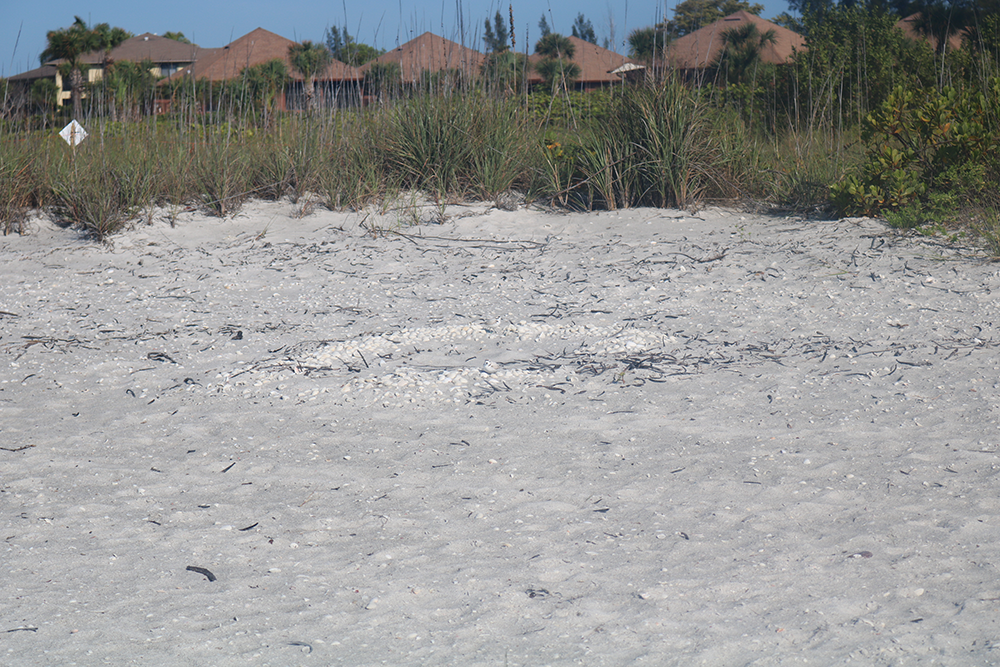
For my first bird outing, I joined Audrey Albrecht, the shorebird biologist at SCCF, and shorebird intern Elsa Wilson as they monitored the nesting activity of Sanibel’s five pairs of snowy plovers. In addition to checking on the nests, they hoped to gain insight into the island’s role in sustaining the population of this state-threatened species. Fortunately, these fluffy white birds roughly the size of a golf ball are no more scary than, well, a fluffy golf ball.
At the beach, Albrecht and Wilson counted the eggs the plovers had laid and made sure the enclosures that protect the nests from people and dogs were still intact. Flushing (or chasing away) the adult birds leaves the eggs vulnerable to overheating and being seized or eaten by crows, gulls and ghost crabs. The pair also picked up trash that can attract predators and fishing line that can entangle the birds. Beachgoers should “remember that they’re a guest in the home of all the coastal wildlife that lives and nests on the beach,” Albrecht said.
As we walked along the beach, Albrecht encountered a double-crested cormorant that didn’t fly away as she approached. She was concerned it might be affected by red tide, a harmful algal bloom of the phytoplankton Karenia brevis that produces a neurotoxic compound. This species, which fishes all over the region, serves as a canary (or, rather, cormorant) in the coalmine for red tide, Albrecht explained.
As she inspected the cormorant, it flew away, and with it the dilemma of whether to capture the bird and bring it to Sanibel’s Clinic for the Rehabilitation of Wildlife (CROW) for treatment. When I spoke with Breanna Frankel, the wildlife rehabilitation manager at CROW, in mid-April, she had seen about 112 patients with red tide symptoms so far this year, and all of them were shorebirds. These birds suffer a host of health impacts ranging from loss of function in their legs to tremors and twitching to total disorientation. “It could go either way for every single patient,” she said. “They walk through the door, and they maybe have a 50% chance of survival.”
We were all relieved the cormorant seemed to evade this fate. I was especially relieved to not be anywhere near a large bird being wrestled into a carrier.
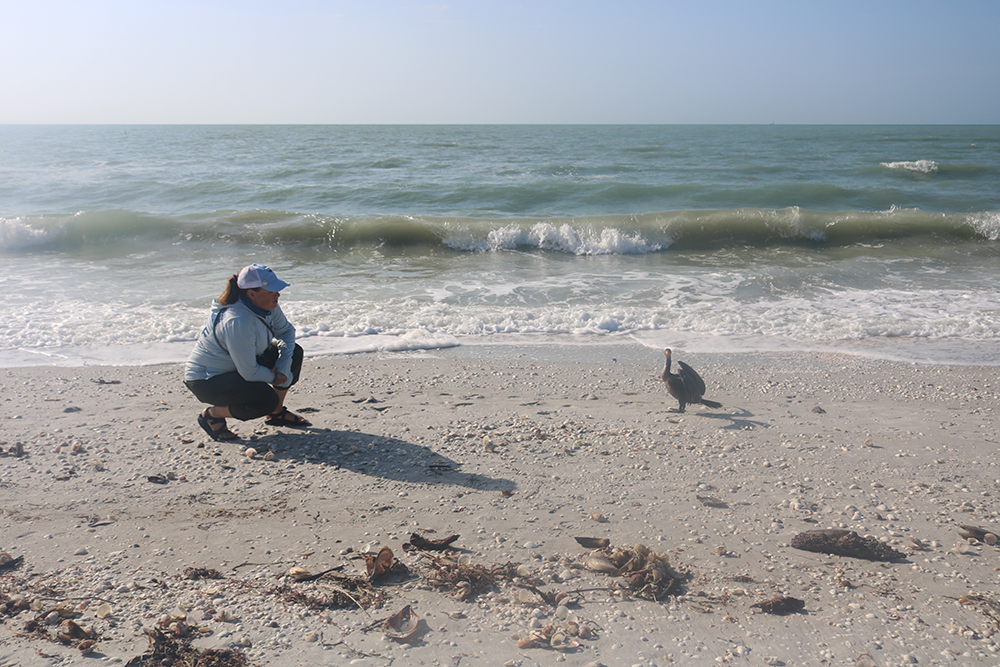
As we piled back in the truck after a blissfully uneventful morning, I confessed my fear. “We won’t take you to see the terns,” Albrecht replied. “They will dive bomb you.”
With that very firm boundary established, I continued to join the team as they surveyed less… social… species. One day, I tagged along for a 3.6-mile leg of a monthly shorebird survey of the entire Sanibel-Captiva coastline and a breeding bird survey for the Florida Shorebird Alliance to better understand declining shorebird populations. As she tallied a cluster of birds dancing in and out of the lapping water, Albrecht pointed out the banded sanderling PO3. I was immediately drawn to this bird because my French-Canadian husband, Pierre-Olivier, often goes by PO. When she told me PO3 migrates to Sanibel every winter from Canada, I couldn’t believe it.
“I think that birds connects us,” Albrecht said. “People come here and they say ‘I’m from Michigan,’ and I’m like, ‘Okay, well, this little piping plover over here is banded, and it came from Michigan, too.’ Or our red knots connect us to people in Central and South America because the same birds that are visiting our beach are going there. They connect us globally.”
As someone who had just migrated to the island myself, eating dinner alone every night unless my neighbor stopped by to chat through my screened-in porch, it was a comforting sentiment.
We continued walking along the stretch of sand, which grew increasingly narrow until it gave way to a mangrove forest. “There used to be a beach here,” Albrecht said. Sea level rise and shoreline erosion are depleting shorebird habitat, and the construction of sea walls to protect infrastructure further restricts their nesting area, she explained.
We had just emerged from the forest when Wilson pointed and exclaimed, “A rail!” Without another word, she and Albrecht took off, crouch-running in the direction of the bird. The clapper rail, I learned upon their return, is a secretive marsh bird that is often heard but rarely seen. “Sorry, our bird nerd just came out,” Wilson said. She told me she became interested in birding during the pandemic, describing the hobby as “kind of like Pokémon GO in real life.”
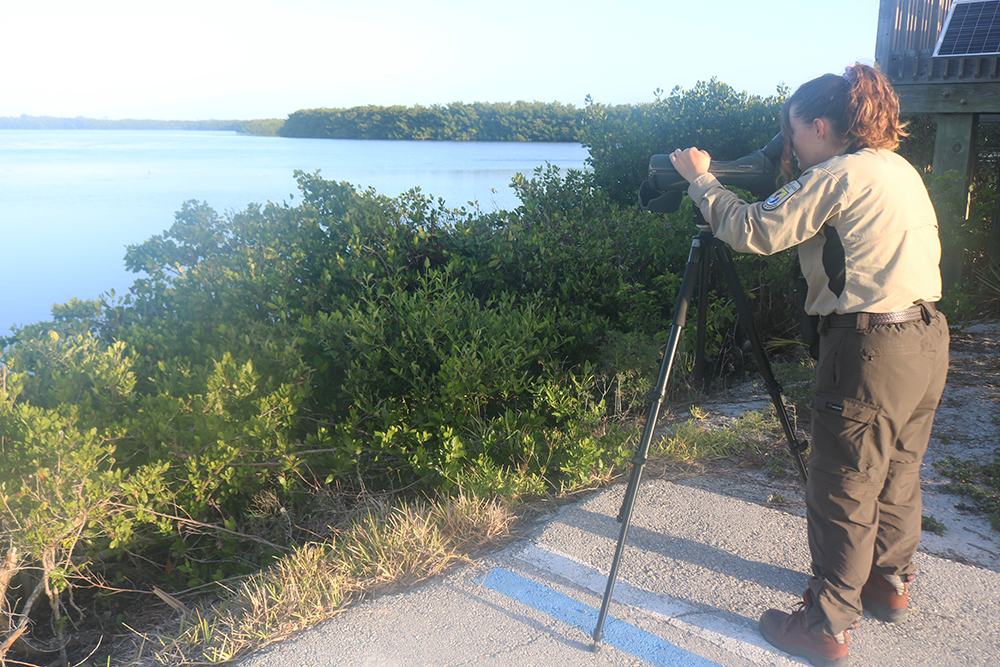
For someone who had actively avoided birds for much of my life, I was unintentionally making decent progress toward “catching ‘em all.” I added many species to my collection when I joined biological science technician Avery Renshaw for a wading bird survey at the J.N. “Ding” Darling National Wildlife Refuge. I could barely keep up with recording the identifications she rattled off as she scanned the landscape with her viewing scope, the far-off blur of feathers crystallizing as tens of distinct birds. As wading birds are an important indicator of the health and function of the estuary, the (hastily scrawled) data can be correlated with water quality measurements to help assess the impact of water management practices on the greater ecosystem, Renshaw explained.
As we strolled through the refuge after the survey, I recognized a lone bird perched on a branch, its wings half-outstretched like a glamorous celebrity being guided down a staircase by two dapper men on either side. In providing directions to her office for a meeting earlier in my stay, a “Ding” Darling staff member had said the door had an anhinga on it. I’d had to Google it, expecting some sort of architectural feature, but instead seeing this bird with its striking stance.
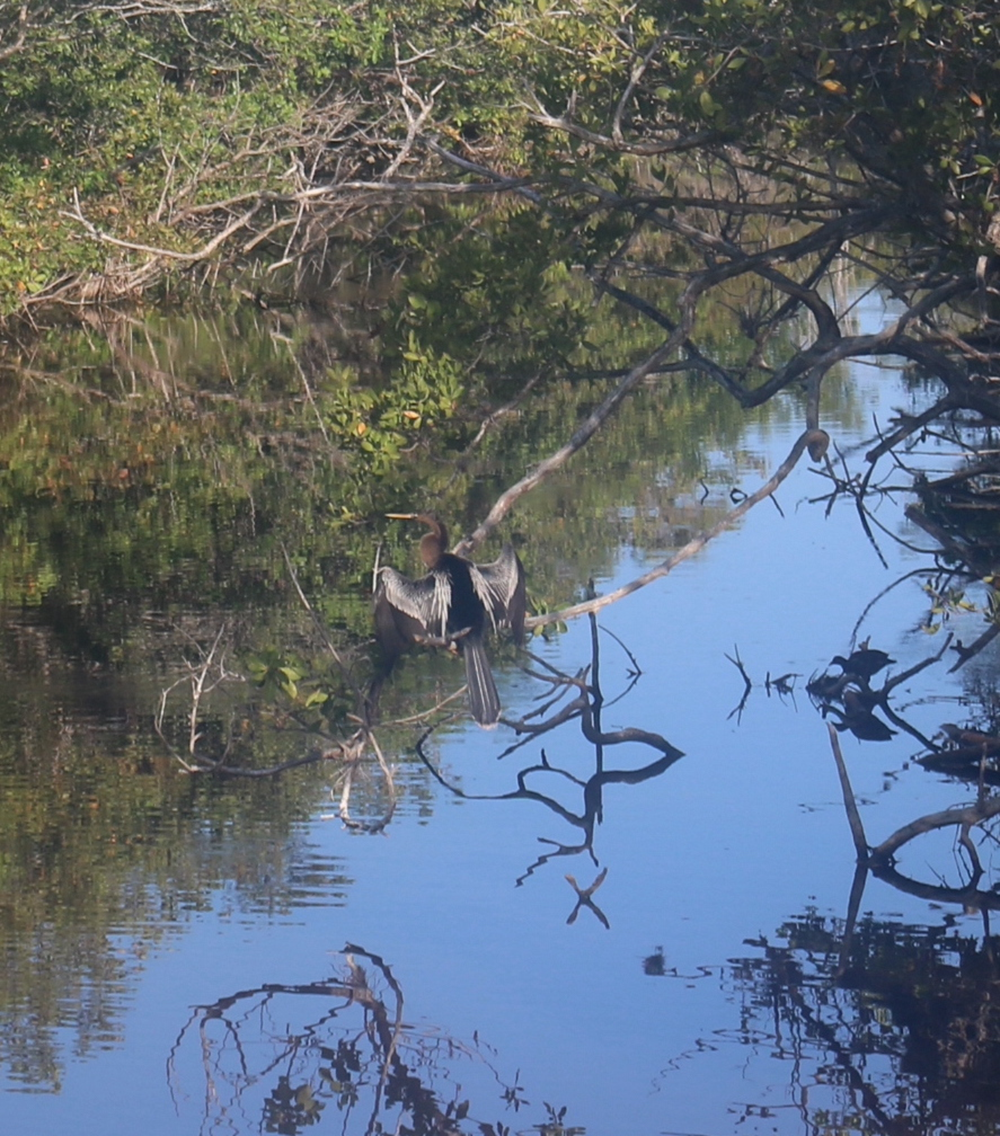
I hesitantly asked Renshaw if the bird was an anhinga. When she confirmed, I found myself eliciting a small fist pump.
“I successfully identified a bird today! What is happening,” I texted my family group chat.
“Maybe you’re going to be their friend,” my mom replied.
“Next year, the Big Year!” my dad chimed in.
Let’s not get carried away, Dad.
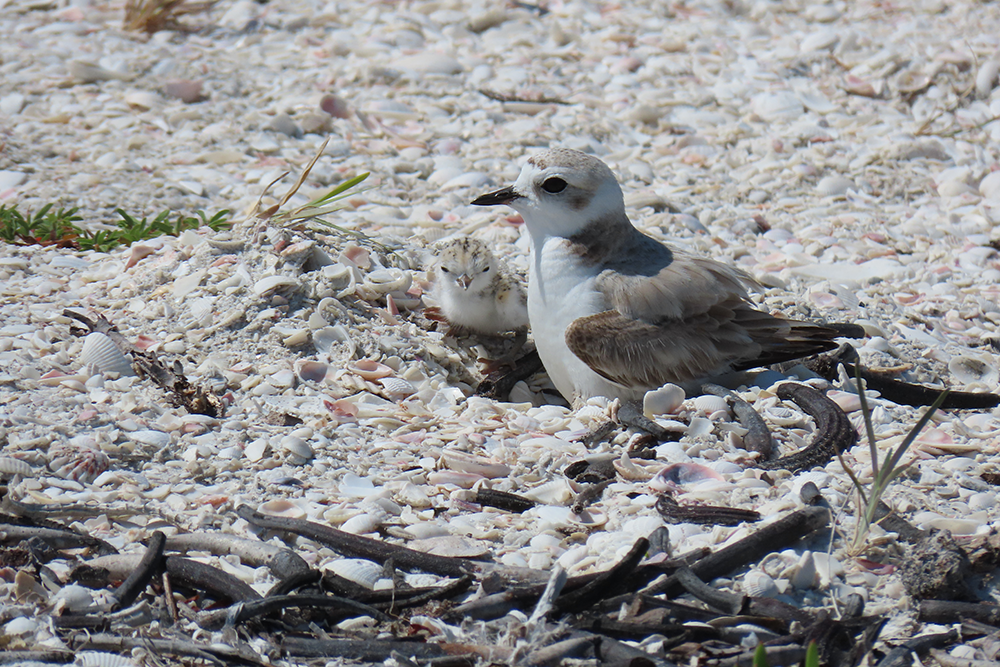
I felt another twinge of excitement when Albrecht told me the first snowy plover chicks had hatched. The next morning, I accompanied Wilson to check on the chicks, whose miniscule size and camouflage against the white sand made them barely visible to the naked eye. Many beachgoers were either entirely oblivious or overly eager about the new arrivals, both of which can lead to disturbances during their precarious first weeks of life.
One woman (who I’m fairly certain had come straight from the Tipsy Turtle bar) stumbled from the dunes at the back of the beach toward the water, threatening to plow through the chicks until Wilson diverted her. While the SCCF shorebird team erects enclosures around frequented foraging grounds, it’s impossible to rope off everywhere the chicks might go, Wilson said.
Moments later, another beachgoer stomped over to the chicks, ogling as she hovered inches away. “Ma’am, do you want to look through the binoculars so you don’t have to get so close?” Wilson asked artfully. After admiring the newborn snowy plovers through the lenses and talking with Wilson, the woman continued on her way, scanning the sand for any chicks that might follow as she walked, her footsteps cautious.
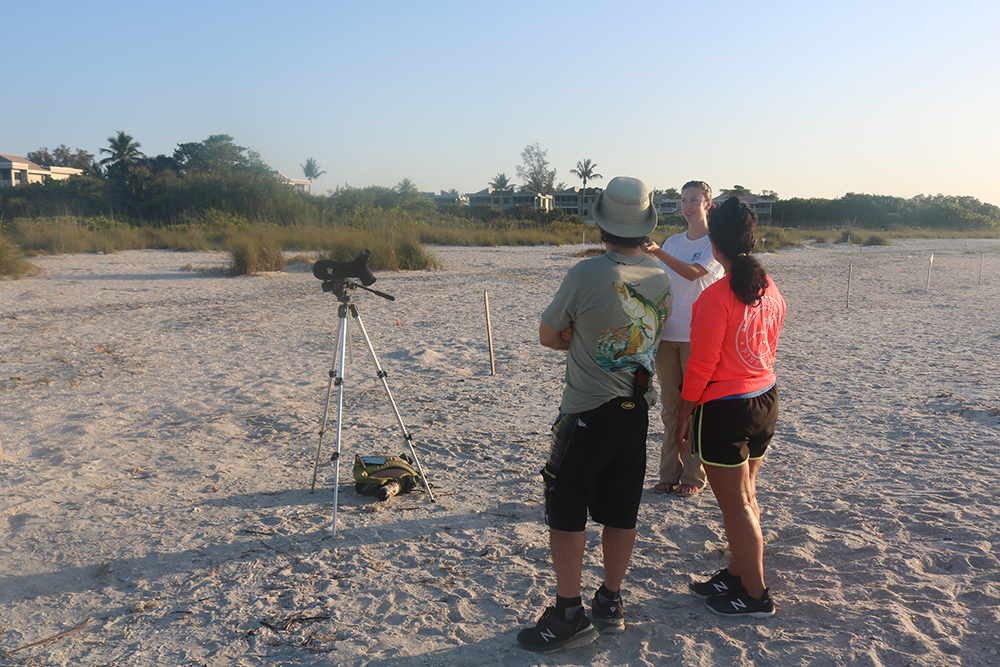
While they’re no match for humans, snowy plovers have the same instinct to protect their offspring. One pair that tried to encroach on another’s nest was promptly shooed away in an adorable little scuffle. “Plover drama!” Wilson sang, and I couldn’t help but feel a surge of fondness for this feisty, fun-sized bird.
For my final bird activity, I joined “Ding” Darling staff members to monitor the nesting efforts of colonial nesting birds on the rookery islands that dot Pine Island Sound. Nests on these rookery islands face many of the same threats as those on the beach, as fishermen and recreational boats that get too close can flush the adults, leaving the eggs and chicks susceptible to predators and heat stress.
At one island, the crew discovered a long trail of fishing line caught in the branches of the mangrove trees. Fearing they would discover a bird ensnared by the line during the next survey, they removed it, trying to keep as much distance as possible. One bird started to flap its wings, though, and I immediately cowered.
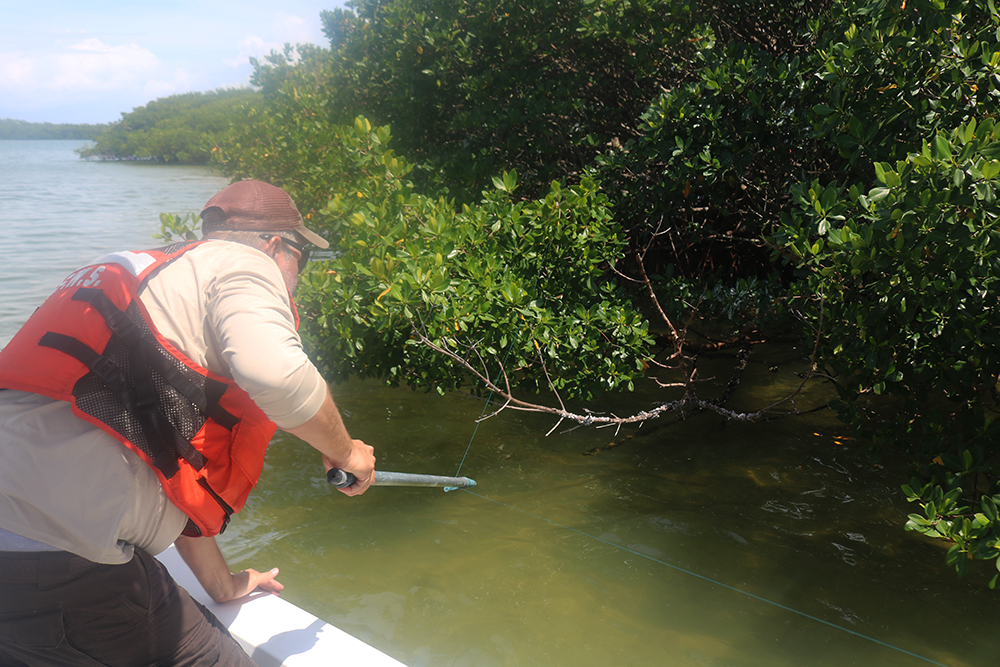
I wasn’t entirely cured, apparently, and will probably always be afraid of birds flying within my personal bubble. But I made significant progress through this informal exposure therapy, appreciating the unique behaviors, personalities and stories of individual birds — from a distance.
Back in Chicago, I descended the stairs into the L station, still giving the flock of pigeons at the entrance a wide berth. I perused Twitter as I waited for the train, stopping on a Tweet I would have scrolled right past before my time on Sanibel. It announced the sudden death of Monty, Chicago’s beloved piping plover, which has since been attributed to a respiratory infection.
I learned that Monty returned to Chicago the week before I did. I thought of all the people who knew this particular bird, who eagerly awaited his arrival at his wintering and breeding grounds, who were connected by his migratory journey.
I considered the many threats Monty faced — exposure to toxic algae fed by nutrient runoff, ingestion of plastic pollutants, shifts in the availability of food in migratory stopover locations due to climate change — and wondered if any might have contributed to his death.
And I realized that, between the two of us, birds have far more reasons to be afraid.